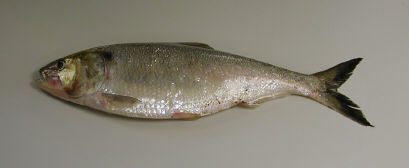
 |
WELCOME TO CHESHIRE BIODIVERSITY
|
|
| HOME | INTRODUCTION | SPECIES | HABITATS | PARTNERS | WHAT'S NEW | WHAT'S ON | OTHER INFO |
Estuaries

The twaite shad and allis shad occur along the Atlantic coast of Europe from southern Scandinavia to the Iberian Peninsula. Both species are also found in the Baltic and the Mediterranean. The allis shad is a migratory, anadromous species occurring mainly in shallow coastal waters and estuaries. During the breeding season (normally May) it enters into rivers with strong currents and stony or sandy beds in order to spawn. After spawning has occurred the adult fish return to the sea whilst the juveniles develop in the rivers and estuary in their first and second year before migrating out to sea. Populations have suffered a severe decline over its distribution range. Whilst adults occur in small numbers around the UK coast there is only evidence of spawning stocks in a few of the UK's rivers, these being notably the rivers Severn, Wye, Usk and the Solway. In June 2002 a 5 year old female Allis Shad was accidentally caught in a Salmon Trammel net in the Welsh side of the Dee Estuary. The fish was autopsied by the Environment Agency and details sent to rECOrd. During the first week in June the previous year another Allis Shad was caught in a similar location in the estuary.
The allis shad is listed on Appendix III of the Bern Convention and Annexes II and V of the EC Habitats Directive. It is also included in Section 9(4)(a) of the Wildlife and Countryside Act (1981), (amended April 1998), which makes it an offence to intentionally obstruct access to spawning areas, or to damage or destroy gravels used for spawning (JNCC's QQR recommendations). The allis shad also continues to be protected under Schedule 5 of the Wildlife and Countryside Act (1981) in respect of section 9(1) so it is an offence to intentionally kill, injure or take specimens. The allis shad is also included in the priority short list of the Steering Group Report (HMSO, 1995).
The twaite shad is a diadromous species occurring in the lower reaches of large rivers. Spawning occurs in fresh water, but about one month later than allis shad and in the lower reaches of the rivers, not more than 100-120km from their mouths. Upon hatching the fry are washed down to the mouth of the river by the current before autumn. They then remain there until the following spring, when they migrate to sea and remain until they are sexually mature.
The species has declined over much of Europe and is virtually absent from many rivers in the UK where it once spawned. The twaite shad has been recorded in the inner reaches of the Dee Estuary but is considered as being rare in the Dee tributaries. However it is unlikely to spawn in this river. In July 2001 six twaite shad were caught in Salmon Trammel nets in the Welsh side of the Dee Estuary.
The species is listed under Appendix III of the Bern Convention and Annexes II and V of the EC Habitats Directive. It is also included in Section 9(4)(a) of the Wildlife and Countryside Act (1981), (amended April 1998), which makes it an offence to intentionally obstruct access to spawning areas, or to damage or destroy gravels used for spawning. The twaite shad is also protected under Schedule 5 of the Wildlife and Countryside Act (1981).
It is also included in the priority short list of the Steering Group Report (HMSO, 1995).
OBJECTIVES |
TARGETS |
To establish the status of the allis shad and twaite shad in the waters of the Cheshire region. |
National Targets1. Confirm the status of the allis shad as a breeding fish in UK waters. Local TargetsTargets awaited. |
ACTIONS REQUIRED |
|
|
|
1997- 2006 Action Completed |
|
Ecology of the Allis and Twaite Shad
UK Allis Shad BAP - www.ukbap.org.uk/UKPlans.aspx?ID=84
UK Twaite Shad BAP - www.ukbap.org.uk/UKPlans.aspx?ID=85
| LBAP Chair | Kevin Buley, Chester Zoo Phone: 01244 650402 |
| National Lead Partners | Department of the Environment, Food and Rural Affairs |
| National Contact | Miran Aprahamian, Department of the Environment, Food and Rural Affairs Phone: 01925 653999 |
Craggs, J. D. (1982): Hilbre - The Cheshire Island.
English Nature (1994): Englands freshwater fish in context, Species Conservation Handbook.
HMSO (1995): Biodiversity: The UK Steering Group Report, Volume 1: Meeting the Rio Challenge, London.
HMSO (1995): Biodiversity: The UK Steering Group Report, Volume 2:Action Plans, London.
Hodgson, B. (19930: The fish fauna of the Cheshire Dee and Tributaries, PhD thesis, unpublished.
Larkins, D. (1996): The Fishes of Cheshire Coastal Waters, Cheshire Wildlife Trust, unpublished.
Lelek, A. (1980): Threatened Freshwater Fishes of Europe, Nature and Environment Series No. 18.
Potts, G. W. and Swaby, S. E. (1994): Marine and Estuarine fishes of Wales.
| HOME | INTRODUCTION | SPECIES | HABITATS | PARTNERS | WHAT'S NEW | WHAT'S ON | OTHER INFO |
|